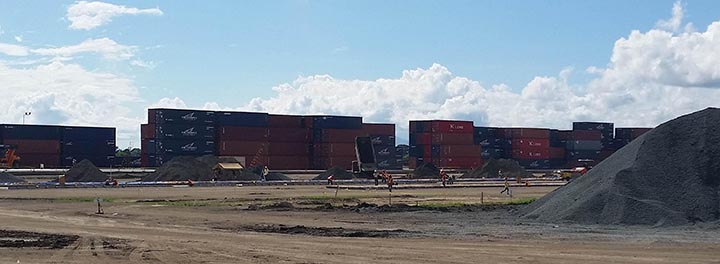 International Container Terminal Services, Inc. (ICTSI) has completed the first section of Phase 1 of its dry port unit, Laguna Gateway Inland Container Terminal (LGICT).
International Container Terminal Services, Inc. (ICTSI) has completed the first section of Phase 1 of its dry port unit, Laguna Gateway Inland Container Terminal (LGICT).
In its official publication, PortFolio, ICTSI said Phase 1 of LGICT includes expansion of new facilities and dedicated storage areas for loaded and empty containers; construction of a rubber-tired gantry (RTG) runway, container care facilities, and weigh bridges; and the upgrade of the access road.
With Section 1 complete, ICTSI said “clients and other stakeholders can expect bigger yard capacity and improved services as LGICT looks to complete the entire Phase 1 Development Project by December.”
The LGICT is a 21-hectare inland container depot that is being developed in Laguna with an earmarked funding of US$30 million (P1.4 billion). Phase 1 covers a 7.22-hectare area with an estimated development cost of P587 million. Initially, the Laguna dry port will have four hectares of operational container yard and use reach stackers to haul containers.
When fully developed, the LGICT will have facilities for reefer containers, truck holding areas, a fuel station, a rail workshop, and container freight stations. For its equipment fleet expansion, it has placed orders for RTGs, side lifters, prime mover trucks, and additional reach stackers.
The ICD is a joint venture between ICTSI, Transnational Diversified Group and Nippon Container Terminals Co. Ltd. Along with the development of Berth 7 at Manila International Container Terminal (MICT), the ICD will increase the terminal’s capacity by 20% to 4.2 million twenty-equivalent units. ICTSI also has expansion plans that include Berths 8 and 9.
ICTSI said LGICT will help lower MICT’s import inventory, average import dwell time and laden yard utilization by offering storage services to clients in Southern Luzon.
As a regional logistics hub, LGICT will provide logistical support to manufacturers, importers, and exporters in economic zones within the CALABARZON (Cavite, Laguna, Batangas, Rizal and Quezon) area by reducing truck turnaround time and accelerating trade, according to the port operator. It added that the facility offers both short-term and long-term storage options as well as transport service to and from MICT.
Meanwhile, the port operator recently upgraded the terminal operating system at MICT to Navis N4 2.6 from Navis 2.2.
Version 2.6 has several improved features including easier N4 node administration, greater number of supported browsers and operating systems, additional security features on the N4 installer, better system and database performance monitoring, enhanced configurability, and improved application modules.
“The upgrade resolved system performance concerns and cache issues,” Information Technology Systems and Services manager Francis John Valdez said.
“The project gave us a chance to include more system validations and tighten security processes for operations,” OP Gates assistant manager Adelino Vestil added.
MICT said it is the first terminal of its size in the world to successfully implement Navis N4 2.6.





